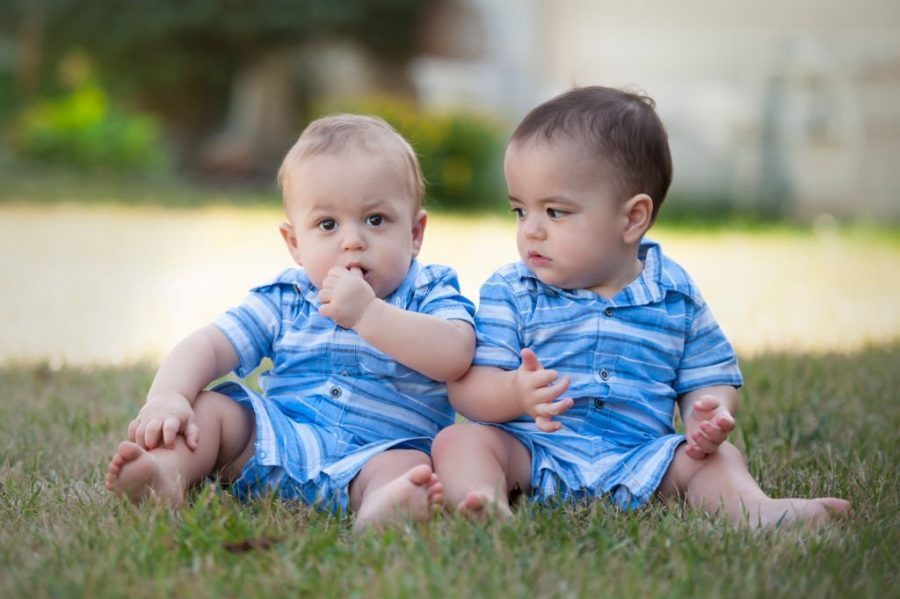Have you ever wondered how two different people share an uncanny resemblance? They look alike with almost similar features. The fact lies in the remarkable phenomenon that has fascinated genetics and researchers. A unique biological process that results in the formation of identical twins has captivated humanity. They not only share a physical resemblance but also share the same genetic makeup.
In this remarkable journey, we will be unveiling the mystery behind the genetic inheritance and similarity of identical twins. By diving into the genetic world of DNA, we will find the answer to a common query, do identical twins have the same DNA? In addition to this, we will discover the importance of a Sibling DNA Test.
Understanding the Genetic Basis of Identical Twins:
The extraordinary phenomenon of identical twins has fascinated human beings. When a fertilized egg divides into two embryos, identical twins are originated. These fertilized zygotes are implanted and develop into identical twins throughout the early stages of development.
DNA carries all the information regarding the reproduction and development of the human body. In addition to this, it contains all the required information for normal functioning that is inherited from generation to generation.
DNA contains a distinct pattern of genetic features that is present at the start of a zygote. This genetic material is duplicated and distributed to the other zygote when an egg divides. This unique phenomenon of replication ensures the even distribution and similarity of the genetic makeup in both zygotes.
How Many Types of Twins are there?
Explore the uniqueness of identical twins by learning more about this remarkable biological process. Based on the fertilization and development process, only two types of twins are there that carry similar genetic makeup.
-
Identical Twins.
Monozygotic twins are formed through a fascinating biological process. When a single sperm fertilizes a single egg. That fertilized egg undergoes division and forms two identical embryos. During the process of division, not only the embryo divides but genetic material is also replicated. Genetic makeup is distributed equally to both zygotes. This type of twins shares more physical resemblance and genetic markers. As they are produced from a single fertilized egg, they usually have the same sex.
-
Fraternal Twins.
Fraternal twins are originated when two sperm fertilize two different eggs. These fertilized eggs need no division, as they grow simultaneously. Both zygotes will have a separate genetic makeup that needs no replication. Moreover, fraternal twins developed from different egg cells may or may not have similar sex. Just like the other siblings, they share 50% of the genetic content.
What are Identical Twins?
Monozygotic twins are produced when a single egg fertilizes with a sperm. After the complete process of fertilization, the egg undergoes division that leads to the splitting of the embryo. This remarkable natural process takes place during the development phases. Consequently, it results in the formation of two identical individuals.
Here are some similar features of identical twins.
- Identical genetic makeup.
- Usually have similar gender.
- Similar facial resemblance.
- Identical physical traits.
Do Identical Twins have the Same DNA?
The answer is yes; identical twins DNA Testing usually has the same genetic content. This genetic content is distributed equally when an embryo undergoes the process of division. Identical twins born from single-fertilized eggs, carry similar genetic makeup. Moreover, both zygotes undergo DNA replication for equal distribution of genetic material.
DNA carries all the genetic content that is replicated during the process of division. This replicated genetic content is ultimately distributed equally to both zygotes. Hence, identical twins have a similar genetic makeup. Despite carrying a similar genetic makeup, they might exhibit different traits due to some environmental factors.
Do Identical Twins have the Same DNA Fingerprints?
Fingerprints are the unique set of impressions that identify an individual in a population. Fingerprints are a remarkable and powerful tool in the forensic world for crime investigations. Despite having similar genetic makeup, identical twins do not exhibit similar fingerprints.
Fingerprints are the unique pattern that is developed during the growth and development phases of a fetus. Depending on the skin pressure, amniotic fluid, and finger positions, fingerprints change accordingly. Even though twins carry similar genetic material, they possess different fingerprints, just like others.
Can Identical Twins look Different?
Despite sharing similar genetic material, they may exhibit different physical traits. Some factors can affect the visual appearance of twins.
-
Genetic Modifications:
Genes are the small portions of DNA that carry information about genetic traits, and identical twin DNA has some specific genetic markers. Every gene regulates and controls the expression of a trait. Modifications of gene expression may lead to variations in genetic traits such as facial features.
-
Environmental Factors:
Identical twins carry similar genetic makeup, regulating genetic traits. Eventually leads to similar physical traits and facial resemblance. But these physical traits may be influenced by some environmental factors, such as stress, diet, health, or lifestyle.
-
Sudden Mutations:
Sudden changes or modifications in the DNA sequence may lead to some genetic changes. During the growth and development phases, mutations may occur that will consequently lead to some genetic differences. These mutations will gradually alter the genetic content that regulates physical traits.
-
Lifestyle:
As an individual grows, his priorities and preferences change with time. Some lifestyle choices, like hairstyle, clothing, and makeup, will influence the physical appearance of an individual.
-
Surgeries:
In this modern world, where trends and patterns change daily. Some people change their visual features through plastic surgery to enhance their looks. By employing some surgical techniques, identical twins can change their physical appearance.
What are Fraternal Twins?
Fraternal twins are dizygotic twins because they developed from two different zygotes. When two different sperm cells fertilize two different eggs, fraternal embryos are produced. They fertilized and reproduced independently. Unlike monozygotic twins, fraternal embryos do not need to replicate the genetic content. As they reproduce independently, they do not share genetic material but carry their own genetic content.
Fraternal twins have the following characteristics.
- Only a 50% similarity in genetic content.
- Shared genetic markers like other siblings.
- May or may not have similar genders.
- Different physical traits.
- Different personalities and looks
What is the difference Between Identical and Fraternal Twins?
Based on the reproduction and development processes, there are two types of twins. Here are some prominent features in support of identical vs fraternal twins.
-
Fertilized Egg:
A single fertilized egg produces identical twins. On the other hand, fraternal twins are produced by two sperm. What happens is, both sperm fertilize two different eggs, resulting in the formation of two embryos. In the case of identical twins, the fertilized zygote undergoes division, forming two similar embryos.
-
Genetic Similarity:
Identical twins carry similar genetic material that eventually influences their physical traits. On the other hand, fraternal twins develop independently and carry a 50% degree of similarity in their genetic material.
-
Replication of Genetic Material:
Identical twins reproduce from a single fertilized egg, that contains genetic material for a single embryo. The second embryo needs an equal amount of genetic material. Consequently, twin DNA replication takes place for equal distribution of genetic material. On the contrary, DNA replication does not take place in the case of fraternal twins. Both embryos have their own genetic material and develop independently.
-
Physical Traits:
Similar genetic makeup will eventually lead to the development of similar physical traits. Identical twins with the same genetic content exhibit similar looks and features. On the other hand, fraternal twins exhibit somewhat different physical appearances and display different personalities.
-
Gender:
Identical twins carry similar genetic makeup and come from the same fertilized egg. They always exhibit similar sex, either male or female. Contrary to this, fraternal twins with 50% genetic similarity display both types of sex. It can be either the same or different gender.
-
Fingerprints:
Fingerprints are the unique pattern that is developed during the growth and development phases of a fetus. Depending on the skin pressure, amniotic fluid, and finger positions, fingerprints change accordingly. Even though twins carry similar genetic material, they possess different fingerprints, just like others.
How Much Does a Sibling DNA Test cost?
Our sibling DNA test costs range from $320-$400.
What Does Fraternal Twins Mean?
Fraternal twins, otherwise known as dizygotic twins, are two different individuals that have a common reproductive origin. They are developed at the same time but from two different ovulated eggs. A condition in which two sperm fertilize two different eggs will lead to the origination of fraternal twins.
The fertilized embryos are then implanted in the uterus for further development of the fetus. Despite having 50% similar genetic makeup, fraternal twins exhibit different physical appearances and features.
Do Fraternal Twins have the Same Blood Type?
Fraternal twins don’t need to have similar blood types. Identifying the blood type and recognizing an individual has revolutionized the medical world. Blood type determines a person’s identity. This trait is controlled by multiple alleles, and which allele is inherited is unpredictable.
Fraternal twins grow and develop independently with their genetic material. They have their own set of genes and alleles that they inherit. A single or combination of alleles inherited from the parents will determine the person’s blood type.
The twins may carry a similar combination of alleles and develop similar blood types. On the other hand, if they inherit different combinations of alleles, twins will eventually have different blood types.
Do Fraternal Twins Share a Placenta?
A placenta is a sac-like structure that holds all the nutrients and oxygen coming from the mother. A fetus undergoes the process of growth and development in this structure. Depending on the condition of fertilization and the position of the implanted fetus, a fraternal twin may share the same placenta.
A condition in which embryos implant themselves very close to each other, their placenta merges together. Under these circumstances, twins will share the same placenta. On the contrary, if implantation happens where placentas do not fuse, twins will have separate placentas.
When are Fraternal Twins Usually Born?
Fraternal twins develop from different fertilized eggs, and both embryos undergo similar stages of growth and development. Just like in a normal pregnancy, fraternal twins are usually born at any time during the gestation period.
Depending on the medical issues of the mother, pregnancy complications, and the position of the children, delivery time may vary. However, carrying twins may put some stress on the mother’s body, which may influence the delivery schedule. It is crucial to keep monitoring the health of the mother and the babies throughout the pregnancy period.
Does Twins Skip a Generation?
The probability of having twins varies, depending on multiple factors. The fact that twins skip a generation is not completely supported by genetic factors. Whereas some environmental factors may influence the likelihood of having a twin.
Whether fraternal or identical, twins may appear in multiple generations without following any genetic pattern. Many families conceive twins without having a previous background of identical or fraternal twins.
Can Twins have Different Fathers?
Under very specific and rare circumstances, twins can have different fathers. That is when the mother is ovulating and releases multiple eggs while having intercourse with two different men. In that case, the mother can have a twin pregnancy with two biological fathers. This condition is specifically called hetero-paternal superfecundation. This situation rarely happens in humans but is common in animals.
In common cases, eggs are fertilized with the sperm of the same man, and twins have the same father. If you are curious about who the biological father is, you can go for a paternity test. For personal assurance and peace of mind, a paternity DNA test is your best option. Understanding your needs, Face DNA offers a DNA paternity test to give strength to your relationship
Can Two Sperms Fertilize one Egg?
From a clinical point of view, this may not be possible. Only one sperm can fertilize the egg. This is because sperm eventually forms a protective layer around the egg after entering it. This barrier will protect the egg from other sperm.
In rare cases, where two sperm fertilize the egg, multiple medical complications can affect the pregnancy. This will lead to the multiplication of genetic material and chromosomal abnormalities. During the natural phenomenon of reproduction in humans, this condition can not occur.
What are Maternal and Fraternal Twins?
Maternal is another name for a monozygotic or identical twin, while fraternal twins are non-identical twins. Here are some common features that give a clear insight into maternal vs fraternal twins genetic relatedness.
- Maternal twins are the product of single-egg fertilization, and fraternal twins originate from two fertilized eggs.
- Maternal twins have similar genetic content, while fraternal twins share only 50% of the genetic similarity.
- Maternal twins may exhibit similar physical characteristics, while fraternal twins show different physical and personality traits.
- Maternal twins are usually of similar sex, while fraternal twins can have both similar and dissimilar sex.
- Both types of twins may or may not share the same placenta, depending on the condition of implantation.
How do I Know about my Biological Twin?
Twins share a strong emotional bond and are a constant support system for each other. They are built-in best friends and long-term companions. Despite having different personalities and unique identities, they share a strong biological connection. If you are curious to know and confirm information about your biological twin, a sibling DNA test is your go-to option.
Siblings DNA Test is a sort of DNA test that examines and identifies shared genetic markers. Firstly, genetic professionals will create genetic profiles of claim twins. These genetic profiles are then compared and analyzed to know are identical twins genetic or biologically connected.
Are you looking for an affordable place for a sibling DNA test? Look no further, Face DNA provides a sibling DNA test service along with professional consultation. From consultation to testing services, they provide reliable and accurate services at an affordable cost.
Final Thoughts:
Understanding the biological phenomenon that results in the formation of identical twins is fascinating and has gained fame just like Olsen twins fraternal. Explore and discover the biological connection with the twin through a sibling DNA test. If you want to know more about the biological connections between twins, a sibling DNA test is the best option. Unveil the genetic mysteries and establish the genetic lineage through our Face DNA Test services. Face DNA offers its services at an affordable cost.







Leave a Reply
Your email is safe with us.
You must be logged in to post a comment.